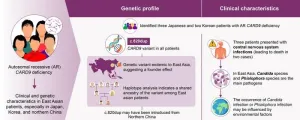(Press-News.org) Food insecurity, low household income and not having private health insurance are associated with higher rates of prediabetes in adolescents, independent of race and ethnicity, according to a new JAMA Network Open study by University of Pittsburgh and UPMC researchers.
The findings suggest that screening for social determinants of health — the non-medical factors that influence a person's health and risk of disease — may help identify youth at risk of prediabetes, which could ultimately improve early interventions that prevent progression to type 2 diabetes.
“This study underscores the importance of using social factors, which are modifiable — meaning that we can address them — to understand and reduce diabetes risk in adolescents as opposed to personal, non-modifiable characteristics like race and ethnicity,” said senior author Mary Ellen Vajravelu, M.D., M.S.H.P., assistant professor of pediatrics at Pitt and pediatric endocrinologist at UPMC Children's Hospital of Pittsburgh. “Many medical guidelines are moving away from the use of race and ethnicity to determine care and screening practices because it can exacerbate disparities instead of reducing them.”
Prediabetes is defined by higher-than-normal blood sugar, which can progress to type 2 diabetes if not addressed with lifestyle changes such as diet and exercise.
“In our clinic we see a lot of adolescents with type 2 diabetes, which is a very serious condition when it starts in childhood,” said Vajravelu. “Current guidelines for identifying children at high risk for type 2 diabetes and prediabetes use characteristics such as body size, race, ethnicity and family history, but those risk factors still don't fully explain who presents with type 2 diabetes in childhood.”
According to Vajravelu, type 2 diabetes and prediabetes are more prevalent among youth who identify as Native American, Alaska Native, Asian, Black and Hispanic than their white counterparts. However, because these minoritized groups are also more likely to experience adverse social determinants of health, it is likely these social factors, rather than race itself, that influence disease risk.
To better understand the role of social determinants of health in youth-onset prediabetes, Vajravelu and her team used a large national database to identify 1,563 participants aged 12 to 18 years and with obesity, 8.5% of whom had elevated blood glucose, or hemoglobin A1c, indicating prediabetes. Then, they looked at three social determinants of health related to diabetes management: food security, health insurance and household income.
Adverse scores for all three were linked with prediabetes risk: Prevalence of prediabetes was 4.1% higher among participants from households with food insecurity compared to those with food security, 5.3% higher in youths with public compared to private insurance, and 5.7% higher in youths with household income at less than 130% of the federal poverty level compared to those with higher incomes.
The associations of these risk factors with prediabetes also differed within racial and ethnic groups, underscoring the importance of considering social determinants of health when understanding type 2 diabetes risk.
For example, in white children, who are traditionally considered at lower risk for prediabetes, going from having one to two or three adverse social determinants of health quadrupled the prevalence of prediabetes.
“If we use race and ethnicity to guide us in identifying children at risk of prediabetes, it could steer us away from screening children who do not fall into a higher risk race or ethnicity category,” said Vajravelu. “Instead, if we tailor our screenings based on exposure to risk factors, not race, we might be able to pick up additional children who are at risk for diabetes.”
Adverse social determinants of health could influence diabetes risk in several ways. For example, families experiencing food insecurity are less likely to have access to healthy foods to prevent diabetes and those without private insurance may have more limited access to health care.
There are many more social factors that could also impact diabetes risk that the researchers did not look at in this study, including diet quality and healthy lifestyle factors. Including additional factors could improve identification of children at risk for prediabetes in the future.
A limitation of the study is that hemoglobin A1c levels were from just one snapshot in time and the researchers were not able to track whether children went on to develop diabetes or not.
In follow-up research, Vajravelu and coauthor Maya Ragavan, M.D., M.P.H., M.S., assistant professor of pediatrics at Pitt, plan to collaborate with community partners to investigate how addressing food insecurity, housing instability and other health-related social needs could improve clinical outcomes for patients with diabetes.
Other authors on the study were Caleb Harrison, Adriana Rodríguez González, M.D., Rutha Chivate, Xu Qin, Ph.D., Margaret Zupa, M.D., M.S., all of Pitt or UPMC; and Vaishnavi Peyyety, of Washington & Jefferson College.
This research was supported by Washington & Jefferson Merck Internship for Excellence in Science Program, the National Institutes of Health (DK065521, K23HD104925, K23DK125719 and KL2TR001856), the Endocrine Fellows Foundation, the Tanner Scholar Advancing Equity grant and UPMC Children’s Hospital of Pittsburgh Health Equity Award.
END
Social determinants of health linked with youth-onset prediabetes
2024-06-11
ELSE PRESS RELEASES FROM THIS DATE:
Harvard, Google DeepMind researchers create realistic virtual rodent
2024-06-11
The agility with which humans and animals move is an evolutionary marvel that no robot has yet been able to closely emulate. To help probe the mystery of how brains control movement, Harvard neuroscientists have created a virtual rat with an artificial brain that can move around just like a real rodent.
Bence Ölveczky, professor in the Department of Organismic and Evolutionary Biology, led a group of researchers who collaborated with scientists at Google’s DeepMind AI lab to build a biomechanically realistic digital model of a rat. Using high-resolution data recorded from ...
Scientists unlock secrets of how the third form of life makes energy
2024-06-11
Scientists unlock secrets of how the third form of life makes energy.
An international scientific team has redefined our understanding of archaea, a microbial ancestor to humans from two billion years ago, by showing how they use hydrogen gas.
The findings, published today in Cell, explain how these tiny lifeforms make energy by consuming and producing hydrogen. This simple but dependable strategy has allowed them to thrive in some of Earth’s most hostile environments for billions of years.
The paper, led by Monash University Biomedicine Discovery Institute scientists, including ...
Would astronauts’ kidneys survive a roundtrip to Mars?
2024-06-11
The structure and function of the kidneys is altered by space flight, with galactic radiation causing permanent damage that would jeopardise any mission to Mars, according to a new study led by researchers from UCL.
The study, published in Nature Communications, is the largest analysis of kidney health in space flight to date and includes the first health dataset for commercial astronauts. It is published as part of a Nature special collection of papers on space and health.
Researchers have known that space flight causes certain health issues since the 1970s, in the ...
Depressive symptoms may hasten memory decline in older people
2024-06-11
Depressive symptoms are linked to subsequent memory decline in older people, while poorer memory is also linked to an increase in depressive symptoms later on, according to a new study led by researchers at UCL and Brighton and Sussex Medical School.
The study, published in JAMA Network Open, looked at 16 years of longitudinal data from 8,268 adults in England with an average age of 64.
The researchers concluded that depression and memory were closely interrelated, with both seeming to affect each other.
Senior author Dr Dorina Cadar, of the UCL Department of Behavioural Science & Health and Brighton and Sussex Medical School, said: “It is ...
New technique could help build quantum computers of the future
2024-06-11
Quantum computers have the potential to solve complex problems in human health, drug discovery, and artificial intelligence millions of times faster than some of the world’s fastest supercomputers. A network of quantum computers could advance these discoveries even faster. But before that can happen, the computer industry will need a reliable way to string together billions of qubits – or quantum bits – with atomic precision.
Connecting qubits, however, has been challenging for the research community. Some methods form qubits by placing ...
Trash-sorting robot mimics complex human sense of touch
2024-06-11
WASHINGTON, June 11, 2024 – Today’s intelligent robots can accurately recognize many objects through vision and touch. Tactile information, obtained through sensors, along with machine learning algorithms, enables robots to identify objects previously handled.
However, sensing is often confused when presented with objects similar in size and shape, or objects unknown to the robot. Other factors restrictive to robot perception include background noise and the same type of object with different shapes and sizes.
In Applied Physics Reviews, by AIP Publishing, researchers from Tsinghua University worked to break through the difficulties ...
Shedding light on the origin of a genetic variant underlying fungal infections
2024-06-11
Researchers from Japan uncover the genetic diversity and regional patterns of CARD9 deficiency in patients susceptible to fungal diseases
Tokyo, Japan – Fungal infections pose life-threatening risks, especially when vital organs or the central nervous system are affected. Individuals harboring variants in the CARD9 gene are particularly susceptible to invasive fungal infections, given that the protein coded by this gene serves as a critical regulator of the immune system. A recent discovery ...
Humanitarian organizations showed flexibility and grit during COVID supply chain disruptions: study
2024-06-11
When the COVID-19 pandemic hit, it sent shock waves across global supply chains. But manufacturers and other businesses weren’t the only ones hit hard: local and international aid organizations, tasked with providing humanitarian assistance during times of crisis, suddenly had a major crisis of their own. How would they get the supplies they needed to carry out their crucial work?
According to a new study by the UBC Sauder School of Business, the organizations showed remarkable nimbleness and ingenuity — and while the pandemic was an unusual event, their approaches can provide powerful insights ...
Research on the visual rabbit illusion takes a leap forward
2024-06-11
Fukuoka, Japan—Researchers from Kyushu University have uncovered new variations to a traditional illusion, based on how we perceive the motion of flashing lights. Published on May 21 in i-Perception, the findings show that when three light flashes are presented in rapid succession in our side vision, our brain tends to perceive them in a straight line, with the second flash around the midpoint, no matter the actual location of the second flash. This research, which earned the journal’s Early Career Best Paper Prize this year, offers new perspectives on perceptual errors ...
Virus-like nanoparticles control the multicellular organization and reproduction of host bacteria
2024-06-11
Tsukuba, Japan—Viruses are ubiquitous in the environment, and organisms have developed various mechanisms to counter their threat. However, the genome of actinomycetes contains a highly conserved gene set encoding virus-like nanoparticles, although its biological significance has remained unclear.
In this study, researchers examined Streptomyces davawensis, an actinomycete species, and discovered that it produces virus-like particles that facilitate host reproduction. Extracellular DNA, which serves as a scaffold for multicellular organization, was significantly reduced in the colonies of mutant S. davawensis strains ...







